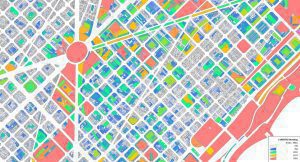
Geomarketing In language there are words that, for some reason, sound good. The ideas, thoughts, behaviors and therefore the relationship between people, are based on words. We understand each other because we use common concepts. Geomarketing proposes, precisely, to approach the concepts of disciplines such as geography and meraketing; bring the concepts of space and market, territory and purchase, people and service.
In short, geomarketing tells us where, who and analyze why. And above all, it allows us to better approximate our hypotheses to future behaviors.
But what is geomarketing on a practical level? A computer tool to the service of marketing or that uses marketing ?, new concepts of analysis that add to existing ones ?, one or several spatial variables to add to existing ones ?, the visualization of the results of a research on a map ?. Actually geomarketing is all this, but it leads unequivocally, to a third stage. The sum of knowledge and geographical techniques and the sum of knowledge and marketing techniques, is not simply a cross-sectional exchange. Actually we are facing a new discipline (as is biomedicine).
The GIS (Geographic Information System) tools have allowed gigantic leaps in public and private investigations, where spatial analysis is fundamental (environment, military, service companies, etc.). This type of tools allow to handle a large number of data and associate them with layers of cartographic information. This enables the analysis derived from the alphanumeric information to add others, such as those obtained from geographical analysis: buffers (areas of influence), optimal distances, optimal locations, clusters, proximity relations (neighborhood), spatial analysis of typologies, etc.
To speak of the applications of geomarketing is always to start with the optimal locations. It is not simply, where to locate a new business? It is also, how long does it take to get to that point, do my potential customers live close by? or is the competition better or worse situated? , for example.
On the other hand, geomarketing, or geographical marketing, allows us to study the socio-economic behavior of the population. This means that the population groups studied have a spatial projection that must be understood and valued. Segmenting these behaviors and classifying them by typology supposes, for example, optimizing commercial campaigns.
Market studies, commercial campaigns, public data, private databases and any data whose value increases in knowing in which spatial environment develops, is likely to be analyzed from this perspective.
Somehow, at present, in the era of “all digital”, we are more territorialized than ever: we travel more, we go further shopping, we use more means and more modes of transport, faster. The tools provided by internet in the world of maps and street maps (OpenStreetmaps, Google Maps, Google Earth, Virtual Earth, Yahoo Maps, …), low cost airlines, websites of travel agencies, housing exchange for holidays, large shopping centers. Mobile phones with GPS are, for example, indicators that our behavior is subject to our ability to travel and move.
Geography and marketing Necessarily both disciplines had to find each other.
(Translation from the original)

Juan Esteban Reina (Barcelona). Degree in Human Geography. Heads the ProdAfrica team.
Spcialist in urbanism, geomarketing and tourism. He is currently developing projects oriented to consultancy especially in fields such as tourism, business and commercial development, as well as promoting business between Africa and Europe.
His passion is Africa. He firmly believes in the future of the continent and the ability of its people to achieve a better future for future generations.